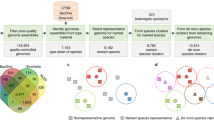Abstract
The Universal Tree of Life, which is based on phylogenetic analysis of the RNA sequence from the small ribosomal subunit, was a breakthrough in understanding the relatedness among all living organisms. The result has had a major impact on taxonomy by separating life into three domains: Eukarya, Bacteria, and Archaea. Indeed, microbiologists have used the 16S ribosomal RNA (rRNA) of the small ribosomal subunit to construct the hierarchical classification of Bacteria and Archaea from the level of domain to genus. However, the 16S rRNA of the Bacteria and Archaea and the corresponding 18S rRNA of the Eukarya are too highly conserved to be useful phylogenetically at the species level. For this reason, I propose that biologists adopt a phylogenomic species concept that utilizes both phylogenetic analyses of less highly conserved genes and proteins as well as genomic analyses for the circumscription of species. If biologists adopt a phylogenomic concept for species, the classification of all living organisms from domain to species could be completed. Furthermore, this universal species concept could help provide a more equitable circumscription among all species, as well as aid in the unification of biologists and biology.


Similar content being viewed by others
References
Woese CR, Kandler O, Wheelis ML (1990) Towards a natural system of organisms: proposal for the domains Archaea, Bacteria, and Eucarya. Proc Natl Acad Sci USA 87:4576–4579
König H, Stetter KO (1989) Section 25 Archaeobacteria. In: Staley JT, Bryant MP, Pfennig N, Holt JG (eds) Bergey’s manual of systematic bacteriology, vol 3. Williams and Wilkins, Baltimore, MD, pp 2171–2173
Staley JT (1989) On using the manual. In: Staley JT, Bryant MP, Pfennig N, Holt JG (eds) Bergey’s manual of systematic bacteriology, vol 3. Williams and Wilkins, Baltimore, MD, pp xix–xxi
Fox GE, Wisotzkey JW, Jurtshuk P (1992) How close is close: 16S rRNA sequence identity may not be sufficient to guarantee species identity. Int J Syst Bacteriol 42:166–170
Mayr E (1942) Systematics and the origin of species. Columbia University Press, New York
Templeton AR (1996) Contingency tests of neutrality using intra/interspecific gene trees: the rejection of neutrality for the evolution of the mitochondrial cytochrome oxidase II gene in the hominoid primates. Genetics 144:1263–1270
Staley JT (2006) The bacterial species dilemma and the genomic–phylogenetic species concept. Phil Trans R Soc B 361:1899–1909
Cracraft J (1989) Speciation and ontology: the empirical consequences of alternative species concepts for understanding patterns and processes of differentiation. In: Otte D, Endler JA (eds) Speciation and its consequences. Sinauer Associates, Inc, Sunderland, MA, pp 28–59
Konstantinidis KT, Tiedje JM (2005) Genomic insights that advance the species definition for prokaryotes. Proc Natl Acad Sci USA 102:2567–2572
Konstantinidis KT, Ramette A, Tiedje JM (2006) The bacterial species definition in the genomic era. Phil Trans R Soc B 361:1929–1940
Goldstein PZ, DeSalle R (2000) Phylogenetic species, nested hierarchies and character fixation. Cladistics 16:364–384
Sneath P (1989) Analysis and interpretation of sequence data for bacterial systematics: the view of a numerical taxonomist. Syst Appl Microbiol 12:15–31
Bishop CJ, Aanensen DM, Jordan GE, Kilian M, Hanage WP, Spratt BG (2009) Assigning strains to bacterial species via the internet. BMC Biol 7:3
Hanage WP, Fraser C, Spratt BG (2005) Fuzzy species among recombinogenic bacteria. BMC Biol 3:6–13
Hanage WP, Fraser C, Spratt BG (2006) Sequences, sequence clusters and bacterial species. Phil Trans R Soc B 361:1917–1928
Wayne LG, Brenner DJ, Colwell RR, Grimont PAD, Kandler O, Krichevsky ML, Moore LH, Moore WEC, Murray RGE, Stackebrandt E et al (1987) Report of the Ad Hoc Committee on Reconciliation of Approaches to Bacterial Systematics. Int J Syst Bacteriol 37:463–464
Ursing JB, Roselló-Mora RA, García-Valdés E, Lalucat J (1995) Taxonomic note: a pragmatic approach to the nomenclature of phenotypically similar genomic groups. Int J Syst Bacteriol 45:604
Mayr E (1998) Two empires of life or three? Proc Natl Acad Sci USA 95:9720–9723
Staley JT (1997) Biodiversity: are microbial species threatened? Curr Opin Biotechnol 8:340–345
Baas-Becking LGM (1934) Geobiologie of inleiding tot de milieukunde. Van Stockkum & Zoon, The Hague, The Netherlands, p 263
Finlay BJ, Esteban GF, Fenchel T (1996) Global diversity and body size. Nature 383:132–133
Finlay BJ (2002) Global dispersal of free-living microbial eukaryote species. Science 296:1061–1063
Whitaker RJ, Grogan DW, Taylor JW (2003) Geographic barriers isolate endemic populations of hyperthermophilic Archaea. Science 301:976–978
Moran NA, Munson MA, Baumann P, Ishikawa H (1993) A molecular clock in endosymbiotic bacteria is calibrated using the insect hosts. Phil Trans R Soc B 253:161–171
Hedlund BP, Staley JT (2002) Phylogeny of the genus Simonsiella and other members of the Neisseriaceae. Int J Syst Evol Microbiol 52:1377–1382
Acknowledgments
The author thanks Joel Cracraft and Micah Krichevsky for their helpful comments on the paper. I also acknowledge the U.S. Federation of Culture Collections for their support, in part, for the development of this paper.
Author information
Authors and Affiliations
Corresponding author
Rights and permissions
About this article
Cite this article
Staley, J.T. Universal species concept: pipe dream or a step toward unifying biology?. J Ind Microbiol Biotechnol 36, 1331–1336 (2009). https://doi.org/10.1007/s10295-009-0642-8
Received:
Accepted:
Published:
Issue Date:
DOI: https://doi.org/10.1007/s10295-009-0642-8



